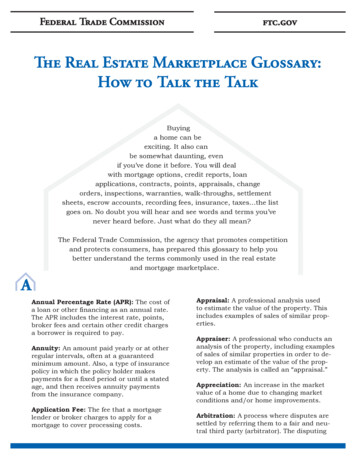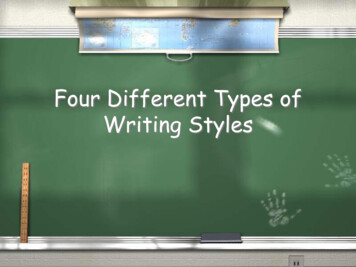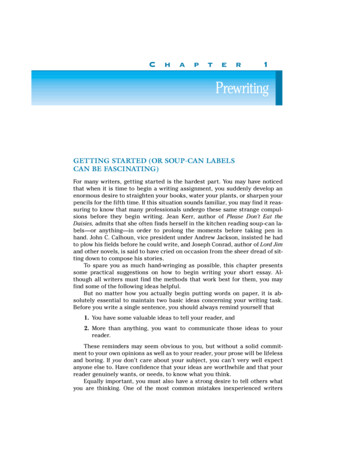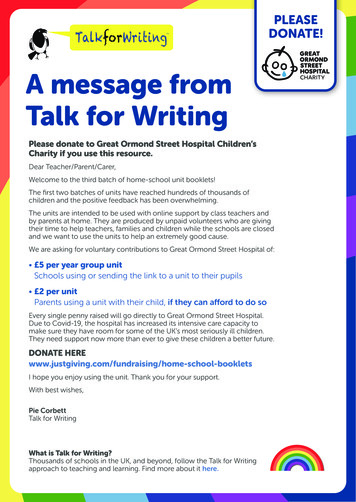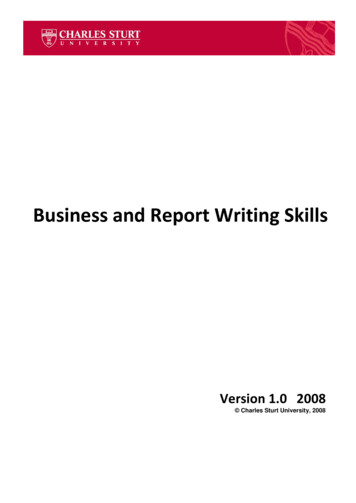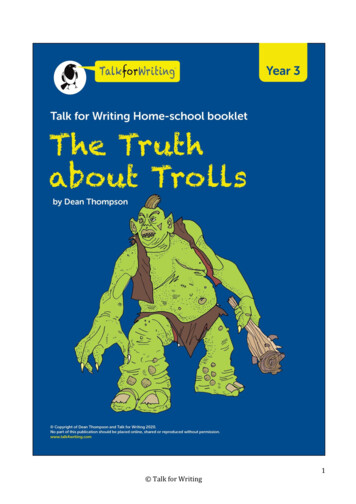
Transcription
Talk for Writing1
The Truth aboutTrollsYear 3 WorkbookBy Dean ThompsonInside you’ll find lots of things to work through that willhelp you with your writing skills and build on the work youdo at school.I’m your virtual teacher, so let's explore together and getyour journey started! Talk for Writing2
IntroductionThere are many stories that have trolls in them. Trolls, like dragons, giants andunicorns, have been talked and written about for hundreds of years. One very wellknown story, I am sure you will know, is about a very angry troll that tried to stopgoats going over a bridge to feed on the rich, green grass.But is this what all trolls are really like?The information that follows has been written by Professor Folklore, an expert onTrolls from the University of Myth and Legend.He provides some basic information on these strange, often misunderstood mythicalcreatures. You can decide what you think maybe true and what needs more researchto establish the truth.Professor Folklore needs other experts to write more about trolls so that the ‘truth’can be shared across the world. He wondered whether you could also become anexpert on trolls. Can you dream up some of your own interesting and amazinginformation to set the record straight and not let trolls just be known as nasty, meancreatures?You can listen to a recording of the story of The Truth about Trolls text below s-7815f2MesfN Talk for Writing3
The Truth about TrollsMany people believe trolls are angry,mean beasts that terrify goats andpeople. However, this is not true. Hereis the truth about trolls.What do trolls look like?Like the ogre, trolls are huge. They lookfierce and ugly but to another troll theyare kind and beautiful. The adult trollhas small, beady eyes, a bulbous, wartynose and sharp, yellow teeth. Mosttrolls have long, curly horns on theirheads similar to a goat. Interestingly, afew trolls do not have any horns at all.No one knows why.Where do trolls live?Trolls are usually found in very cold countries like Iceland. They maketheir homes in caves nearvolcanoes which provideboth warmth and shelter.They live peacefully insmall family groups,hidden away from people.One troll, who was verygrumpy, lived alone undera wooden bridge. Becausehe bullied the local goats,he gave all trolls a verybad name.Photo by Michael Behrens on Unsplash Talk for Writing4
What do trolls eat?Trolls enjoy eating all types of seafood. Trolls fish in total darkness sothat they are not seen by anyone. They mostly eat their food raw.Sometimes, when the volcanoes have erupted, they cook their food on thehot rocks. In addition, they gather large mushrooms and dig up juicy rootsthat grow in the forest. Surprisingly, goats are not on the menu!Did you know?Amazingly, trolls like to have fun. They love singing and dancing. Whenthey sing, it sounds like a rumble of thunder. When they dance, it feelslike an earthquake. Sadly, because of the troll that upset the goats, alltrolls now hide away from view.They can still be seen, though, if you look really hard and believe. Therocks here are actually just sleeping trolls!Professor Folklore‘Friend of the Troll’ Dean Thompson 2020 Talk for Writing5
GlossaryHere’s some help with the tricky technical vocabulary:earthquake: Sudden shaking of theground when the Earth’s surface moves.Can cause terrible destruction.volcano: a hole in the Earth, usually amountain, where very hot, molten rock(magma) and hot gas from the centre ofthe Earth erupts – can cause terribledestructionerupt: the action that happens when avolcano spits out hot molten rock(magma) and gas – can cause terribledestructioncave: Hole or space in rock big enough fora person to go into.Further Information on Earthquakes from BBC q6f/articles/zj89t39Further Information on Volcanoes from BBC q6f/articles/zd9cxyc Talk for Writing6
What do the words mean? Read the information on trolls again. All of the words below are in bold. See ifyou can work out what they mean and jot down your ideas here. If you are stuck, there is a list of similar words below to help you. If you arestill stuck, you could ask someone else in your home to tell you, use adictionary or the internet.Target WordDefinition that fits with the information ullybulliedrawgatherSimilar Words Help Boxscare uncooked collectquietly (not at war)nastybig and swollenangryfrightenedlumpygiant Talk for Writinghome7
Grammar Games Let’s investigate some of the words and phrases that help you towrite interesting information text.The Adjective Game:Adjectives are used describe a noun. For example:The tired, old man wandered over the busy road.To make information writing interesting for the reader you can add adjectives todescribe different nouns. In ‘The Truth about Trolls’, the writer, Professor Folklore,has decided to describe the eyes, nose and teeth of the trolls using two adjectives.These have been separated using a comma as this is a list.small, beady eyes, eyesbulbous, warty nosesharp, yellow teeth, nose, teethTry and think of some interesting adjectives to describe different bits of atroll. Try to make your troll seem friendly or unfriendly.The troll has:,horns,hair,ears,handsChallenge 1: Choose some other parts of a troll to describe using two adjectives.,,,, Talk for Writing8
Challenge 2: Could you use two adjectives that start with the same sound – thisrepetition is called alliteration?For example,bright, bulbous eyeshuge, hairy earsWriting Tip – “Has every word earned its place?”Make sure both adjectives you have used to describe your troll are telling the readersomething different. For example, large, big nose doesn’t work because large and bigare really saying the same thing.Sentence of 3 gameYou can see that 3 features have been used to help describe the troll:The troll has beady eyes, a bulbous nose and yellow teeth.Now use your nouns and adjectives from above to write new sentences of three todescribe your troll.The troll has, and .You need a comma after the first of the three things. Then use and after the second ofthe three things you are describing.The troll has wicked eyes, a hooked nose and terrible breath.Creative challenge: Use your ideas to draw your troll – label the different features. Talk for Writing9
Adverbs are roving reporters because they can move around sentencesdescribing action or whole clauses. They tell you more about the how, where,when and why of everything. Let’s see some of the things that they can do.Add-On Adverbs GameInformation texts have lots of ‘facts’ about a topic. It is helpful to have words that‘add on’ facts for the reader and not just use and and and . .For example, in the ‘Truth about Trolls’, ‘In addition’ has been used as a sentencestarter to ‘add on’ other things that trolls like to eat:In addition, they gather large mushrooms and dig up juicy roots that growin the forest.You need to use a comma after In addition when it is at the start of the sentence.Read the sentence above again out loud and change In addition to Additionally, Alsoor Furthermore. These are other adverbs that help you add on information.What else do you think trolls might like to eat?Write out a list of food here. Try thinking about food you really like or dislike.Challenge: Now tell me a range of food that trolls like to eat – making it seem reallytasty or disgusting! Remember, you can be creative and make things up as you arenow the expert on trolls! Talk for Writing10
Now use the ‘add on’ adverbs below to write some new sentences.Use these sentences to help you.In addition, they enjoy eating large mushrooms and juicy roots.Also, they enjoy eating poisonous mushrooms and rotting roots.In addition,Also,Additionally,Furthermore,Tip – Say your sentence aloud first before you write it down. Does it sound right?Remember to use a capital letter to start, a comma after the ‘add on’ adverb and afull stop at the end of your sentence. Talk for Writing11
Engaging Adverbs GameAdverbs can be used at the start of a sentence to make the informationengage the reader. In ‘The Truth about Trolls’, Professor Folklore has usedInterestingly, Surprisingly and Amazingly to start some of his sentences:Interestingly, a few trolls do not have any horns at all.Surprisingly, goats are not on the menu!Amazingly, trolls like to have lots of fun.Try and think of something interesting, something surprising and something amazingabout your trolls and use adverbs based on these emotions to introduce thisinformation when you write your own engaging sentences.Remember to use a comma after the adverb at the start of the sentence.Interestingly,Surprisingly,Amazingly, Talk for Writing12
Drop-in GameHave a go at dropping extra information into a sentence using a relative clause thatstarts with who. In ‘The Truth about Trolls’, Professor Folklore first wrote:One troll lived alone under a bridge.Then he added in another bit of information using who.One troll, who was very grumpy, lived alone under a wooden bridge.What else could you ‘drop-in’ to tell the reader something else about the troll?One troll, who , lived under a bridge.Use this sentence to drop-in extra information for the reader starting with who.Remember to use a comma before and after the dropped in information.Tip – use a different coloured pen for your drop-in information. Talk for Writing13
Now, let’s think about writing some new information about trolls.In ‘The truth About Trolls’, Professor Folklore used questions as subheadings to help organise his writing and make it easier for the reader.Here is the underlying structure of the professor’s information textabout trolls.Underlying StructureHeading: The Truth About TrollsIntroduction to get reader interested in topicWhat do trolls look like?Where do trolls live?What do trolls eat?Did you know?Keep your best facts for the end! Challenge: What other sections could you add? What is troll school like?What jobs do trolls do?How do trolls look after their babies?What do trolls do on holiday?What is in a troll’s cave? Talk for Writing14
Use the planner below to jot down some ideas for yourinformation on trolls. You can use the ideas from the word and sentence games.Remember you are the new expert!Underlying structureNew Ideas Heading Introduction to getreader interested introllsWhat do trolls looklike?Where do trolls live?What do trolls eat?Did you know?Keep your best factsfor the end! Talk for Writing15
Use the model text and your plan to draft and edit your newinformation on trolls.Challenges:Remember to: give the reader a picture in their head by using adjectives to describe thefeatures of your troll; build up a picture for the reader using a sentence of 3 to describe your troll; link your ideas by using adverbs at the start of your sentences to tell the readeryou are adding on information – see poster A; engage your reader by using adverbs of emotion at the start of a sentence –see poster B. drop-in extra information for the reader by using a relative clause startingwith who.Poster AAdd-on AdverbsPoster BEngaging y,In Addition,Amazingly,Furthermore,Remember to use a commawhen you use these words tostart a sentence.Remember to use a commawhen you use these words tostart a sentence. Read your work through and check that it flows and makes sense Remember to check the spelling and punctuation and illustrate your text withpictures or drawings. Now decide how you are going to publish your information. Talk for Writing16
We’ve reached the end of our journey. I hope you’ve had fun!I really enjoyed I would rate my journey through this booklet (tick hot or cold): Talk for Writing17
This workbook has helped me learn Talk for Writing18
Dean Thompson for Talk for WritingDean Thompson, former teacher and Programme Director for Primary SchoolImprovement with the National Strategies, now works with Talk for Writing to helpschools develop the approach.To find out more about Talk for Writing, visit www.talk4writing.com.This resource is copyright. All materials herein, texts and supporting resources arecopyright to Dean Thompson & Talk for Writing. They are to be used to supportchildren/staff/parents in home-learning ONLY and not for commercial gain or fortraining or sharing widely, in their original form or any variations. They must also notbe shared online or on any social media platforms.Thanks to Jon Ralphs for the cartoons: jonralphs.comPhotos by Anastasiia Chepinska, Jonathan Gallegos, Michael Behrens, Max Saeling& Matty Adame on Unsplash.com Talk for Writing19
Professor Folklore needs other experts to write more about trolls so that the ‘truth’ can be shared across the world. He wondered whether you could also become an expert on trolls. Can you dream up some of your own interesting and amazing information to set the record straight a







